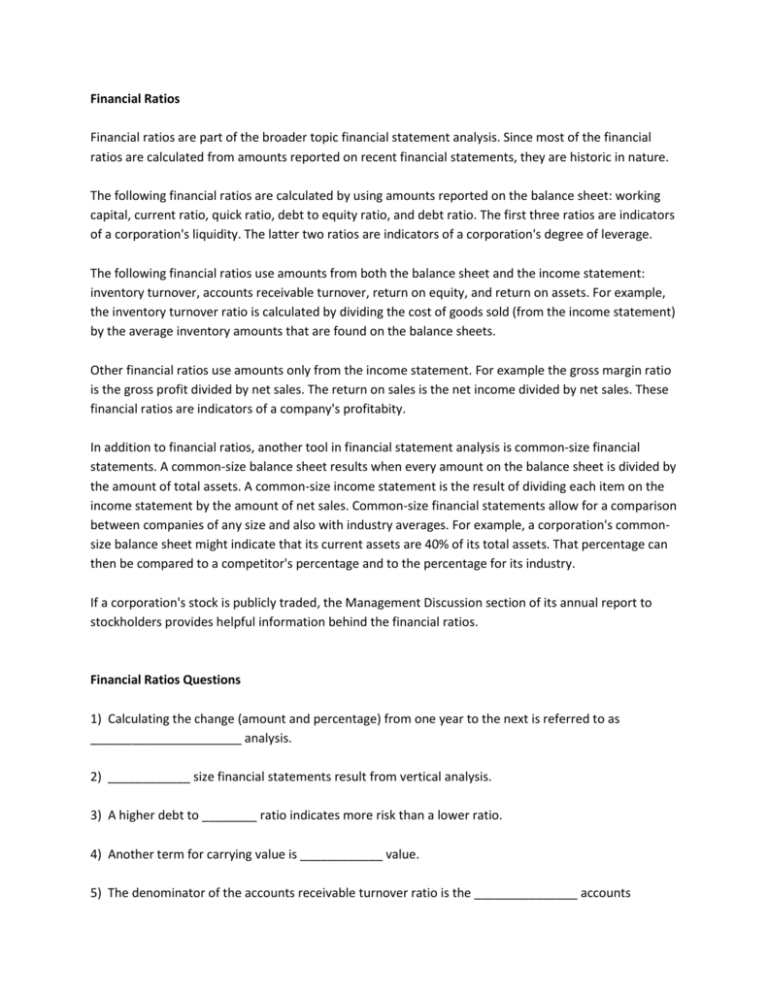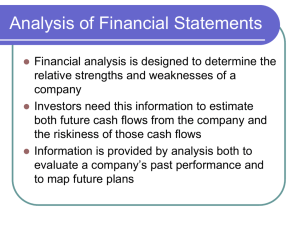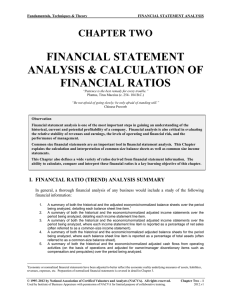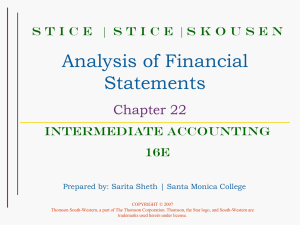File - ISDC Accounting College
advertisement

Financial Ratios Financial ratios are part of the broader topic financial statement analysis. Since most of the financial ratios are calculated from amounts reported on recent financial statements, they are historic in nature. The following financial ratios are calculated by using amounts reported on the balance sheet: working capital, current ratio, quick ratio, debt to equity ratio, and debt ratio. The first three ratios are indicators of a corporation's liquidity. The latter two ratios are indicators of a corporation's degree of leverage. The following financial ratios use amounts from both the balance sheet and the income statement: inventory turnover, accounts receivable turnover, return on equity, and return on assets. For example, the inventory turnover ratio is calculated by dividing the cost of goods sold (from the income statement) by the average inventory amounts that are found on the balance sheets. Other financial ratios use amounts only from the income statement. For example the gross margin ratio is the gross profit divided by net sales. The return on sales is the net income divided by net sales. These financial ratios are indicators of a company's profitabity. In addition to financial ratios, another tool in financial statement analysis is common-size financial statements. A common-size balance sheet results when every amount on the balance sheet is divided by the amount of total assets. A common-size income statement is the result of dividing each item on the income statement by the amount of net sales. Common-size financial statements allow for a comparison between companies of any size and also with industry averages. For example, a corporation's commonsize balance sheet might indicate that its current assets are 40% of its total assets. That percentage can then be compared to a competitor's percentage and to the percentage for its industry. If a corporation's stock is publicly traded, the Management Discussion section of its annual report to stockholders provides helpful information behind the financial ratios. Financial Ratios Questions 1) Calculating the change (amount and percentage) from one year to the next is referred to as ______________________ analysis. 2) ____________ size financial statements result from vertical analysis. 3) A higher debt to ________ ratio indicates more risk than a lower ratio. 4) Another term for carrying value is ____________ value. 5) The denominator of the accounts receivable turnover ratio is the _______________ accounts receivable. 6) One way to determine the number of days' sales in the average inventory is to divide 360 by the inventory ____________ ratio. 7) Horizontal analysis is also referred to as _____________ analysis. 8) Working capital, the current ratio, and the quick ratio are indicators of a company's _________________. 9) For this liquidity ratio, Inventory is excluded from the current assets. 10) RMA (formerly Robert _____________ Associates) publishes financial ratios and other statistics for many different industries and companies of varying sizes.









